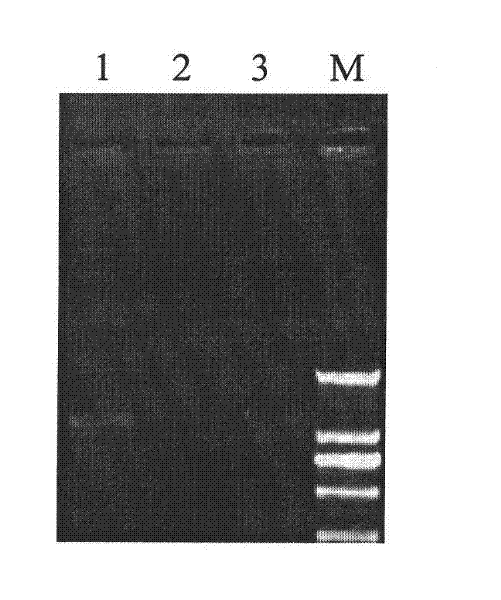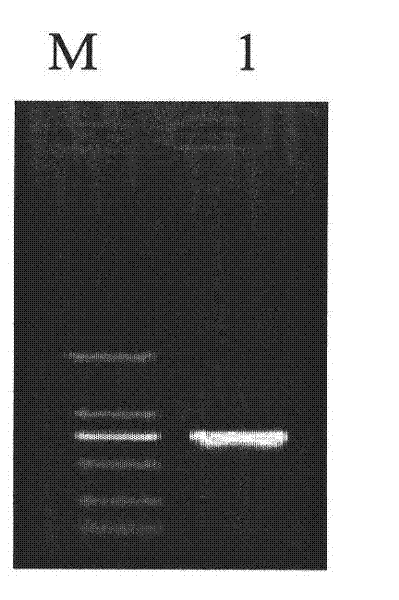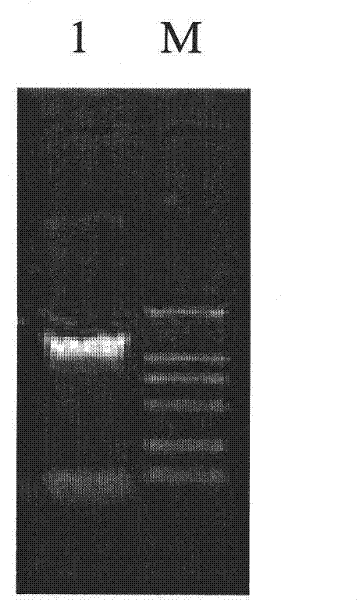Cotton GbSTK gene, encoding protein thereof and application for resisting verticillium wilt of plants
A technology of gene coding and resistance to verticillium wilt, applied in the field of genetic engineering, can solve the problem that the species and quantity cannot meet the needs of crop breeding and production, etc.
- Summary
- Abstract
- Description
- Claims
- Application Information
AI Technical Summary
Problems solved by technology
Method used
Image
Examples
Embodiment 1
[0029] The cloning of embodiment 1GbSTK gene
[0030](1) Cotton planting and inoculation with Verticillium dahliae: the sea island cotton Pima90-53 seeds were develored with sulfuric acid, soaked at room temperature overnight, and the seeds that germinated uniformly were selected and sowed in a nutrient bowl equipped with frog stones. When the cotton seedlings grow to the first true leaf, they are inoculated with the spore suspension of Verticillium dahliae.
[0031] (2) RNA extraction: RNA extraction and reverse transcription use RNA extraction kit and reverse transcription kit (purchased from Beijing Aolibo Biotechnology Co., Ltd.), and operate according to the instructions to obtain double-stranded cDNA (dsDNA) materials.
[0032] (3) cDNA-AFLP: The obtained double-stranded DNA (dsDNA) is digested, ligated, and sequenced to obtain the target differential fragments, and then use the NCBI website expressed sequence tag (expressed sequence tag, EST) database to splice the targ...
Embodiment 2
[0091] Embodiment 2 GbSTK gene prokaryotic expression
[0092] (1) According to the cloned cotton GbSTK gene, design two pairs of primers and add enzyme cutting sites. The primer sequences are:
[0093] Forward primer: 5′-GTC GGTACC AGGAAGAATTCAAGCAAATCC-3′
[0094] (The underline indicates the Kpn I restriction site)
[0095] Reverse primer: 5′-TAC CTGCAG TCAAGGGGCCGTAGGTTGTG-3′
[0096] (The underline indicates the Pst I restriction site)
[0097] The recovered product obtained by PCR amplification (such as image 3 Shown is the amplification result of the open reading frame of the GbSTK gene of the present invention, 1% agarose gel, wherein 1 is the PCR amplification product, M is the DL2000 DNA marker, and a specific band of about 1.3kb is obtained in 1 lane). After recovering the amplified fragment, it was ligated with the pGEM-T vector, and the ligated product was transformed into Escherichia coli competent cells by heat shock method, and positive clones were scr...
Embodiment 3
[0112] Functional analysis and prediction of embodiment 3GbSTK protein
[0113] 1. Using onion epidermal cells as materials to study the distribution of the protein expressed by GbSTK in the cell (that is, the study of the subcellular localization of the protein expressed by the GbSTK gene):
[0114] (1) Design primer sequences: Utilize DNAMAN software to design PCR primers, the sequences are as follows:
[0115] C5-Y: 5′-GTCGACATGAAGAAGAAGCTTGTG-3′
[0116] C3-Y: 5′-CCCGGGAGGGGCCGTAGGTTGTGTAAC-3′
[0117] (2) Amplification of the open reading frame: use the plasmid as a template to amplify the open reading frame of the gene without the stop codon. White spot screening, sequencing, and positive clones containing pGEM-STK with correct open reading frame sequences were screened out for subsequent tests.
[0118] (3) Construction of fusion expression vector:
[0119] The intermediate vector pGEM-STK and the expression vector pCamE-GFP were digested with Sal I and ApaI, respec...
PUM
 Login to View More
Login to View More Abstract
Description
Claims
Application Information
 Login to View More
Login to View More - R&D
- Intellectual Property
- Life Sciences
- Materials
- Tech Scout
- Unparalleled Data Quality
- Higher Quality Content
- 60% Fewer Hallucinations
Browse by: Latest US Patents, China's latest patents, Technical Efficacy Thesaurus, Application Domain, Technology Topic, Popular Technical Reports.
© 2025 PatSnap. All rights reserved.Legal|Privacy policy|Modern Slavery Act Transparency Statement|Sitemap|About US| Contact US: help@patsnap.com



